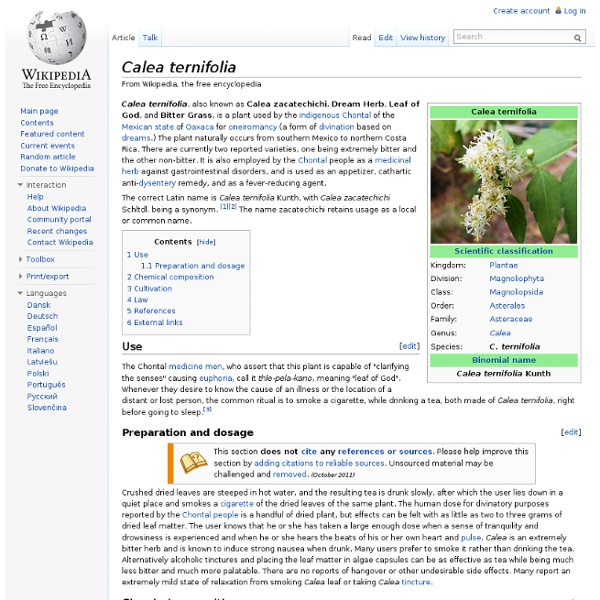APEXvj - Visualize your favourite tunes online
"Your Medicinal Garden: Ten Herbs to Plant This Spring" by Karyn Sweet page two
Stinging Nettles (Urtica dioica) Stinging nettles may be the single most useful herb. It is nutrient dense and it helps to heal an amazing array of disorders. Best of all, it can be eaten like spinach, it's easy to find, and it's free. Some of the disorders that nettles can help heal are: bladder stones, sinusitis, hyper and hypothyroidism, fever, bronchitis, infections, and eczema. This is just a partial list; you can't go wrong if you decide to use nettle for any ailment you have. Nettles are most often found in shady, wet places, usually near a stream or pond. Licorice (Glycyrrhiza glabra) Licorice is an effective support for the endocrine system.
Nootropic
Nootropics (/noʊ.əˈtrɒpɨks/ noh-ə-TROP-iks), also referred to as smart drugs, memory enhancers, neuro enhancers, cognitive enhancers, and intelligence enhancers, are drugs, supplements, nutraceuticals, and functional foods that improve one or more aspects of mental function, such as working memory, motivation, and attention.[1][2] The word nootropic was coined in 1972 by the Romanian Dr. Corneliu E. Giurgea,[3][4] derived from the Greek words νους nous, or "mind", and τρέπειν trepein meaning to bend or turn.[5] Availability and prevalence[edit] At present, there are only a few drugs which have been shown to improve some aspect of cognition in medical reviews. These drugs are purportedly used primarily to treat cognitive or motor function difficulties attributable to such disorders as Alzheimer's disease, Parkinson's disease, Huntington's disease and ADHD. Academic use[edit] Several factors positively and negatively influence the use of drugs to increase cognitive performance. Drugs[edit]
Make Your Own Potting Soil
Related Content How to Make Your Own Paper If you have a lot of excess scrap paper like I do, it’s time to put that waste to better use. Read t... How to make your own potting soil. How to Make Your Own Potting Soil Packaged potting soils are a terrific convenience, but their cost adds up fast in a busy garden. Potting soil self-sufficiency is good for your pocketbook, your plants and the planet, and you actually gain convenience by always having potting soil ready when you need it. Giving Up Exotic Planting Ingredients At least half of any homemade potting soil is homemade compost, but most commercial potting soils are based on some combination of peat moss, perlite and vermiculite — all of which contribute to land degradation and pollution as they are mined, processed, packaged and shipped. Peat moss comes from wetland bogs in Canada or Michigan, which is not sustainable and probably a long, long way from where you live (see Do You Recommend Peat Moss to Improve Soil?). Now for the risks.
Growing Coffee Beans at Home
Growing Coffee Beans at Home Growing coffee plants at home is a rewarding experience that will help you learn and appreciate the work involved in producing coffee. It is a very easy plant to take care of and is a great conversation piece, especially during flowering or cherry development. When home growing coffee beans, you should start with a freshly picked coffee cherry. But unless you are in a producing country, however, this may not be possible and you can skip to section 2. Harvesting Coffee and Preparing the Coffee Seeds Ripe coffee cherries should be harvested and picked from trees with a high production and without any disease or other affliction. Germinating Coffee Beans If coffee cherries are not readily available, green coffee can be purchased from a green coffee supplier, but it is essential that the bean is of a recent crop and recent shipment. It is advisable to pre-germinate the seeds. The seeds should be watered daily. Coffee Plant Care Related Articles Growing Coffee



